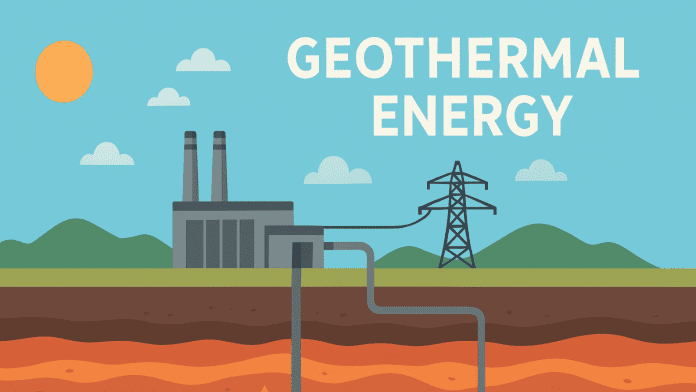🕒 Last updated on September 30, 2025
Geothermal energy comes from Earth’s deep heat, left over from when the planet formed. Unlike solar or wind, it works nonstop, in any weather. Yet it supplies less than one percent of global energy, mostly for heating. New drilling methods from the oil and gas industry may soon unlock far more of this hidden power.
How Geothermal Energy Is Collected
To collect geothermal power, workers drill narrow wells into the ground. These wells can be as shallow as a school bus or as deep as a mountain. When hot water or steam is found underground, it rushes up through the well. This steam can then spin turbines to make electricity, just like in a coal or gas plant—but without burning anything.
In places with active volcanoes or moving tectonic plates, the heat lies close to the surface. Countries such as Iceland, parts of the United States, and the Philippines already use this heat to power cities or warm homes. In colder areas or calmer lands, water can be pumped down, heated by the rocks, and then brought back up again for reuse.
Experts explain it in simple terms: imagine drinking from a juice box with a straw. The well is like the straw, and the hot water underground is the juice. You pull it up, use it, and then refill it again.
New Technologies Creating Fresh Hope
Until recently, many countries could not use geothermal energy because their underground rocks were too dry or too tight for water to pass through. But engineers have started using rock-fracturing methods similar to those used in gas extraction. By carefully cracking the rocks deep underground, they can create pathways for water to move, heat up, and return to the surface.
Congress reviews Trump order to rename Defense Department and weighs its impact on US image
Other teams are developing sealed metal pipes that loop deep into the earth. In these closed-loop systems, no water escapes. It simply travels down cold and comes back up hot in a continuous cycle. Some projects are drilling even deeper, reaching temperatures above 300°C—far hotter than boiling water. A well in Turkey reached almost four kilometers deep and uncovered extreme heat suitable for high-power electricity production.
However, going deeper means stronger equipment and bigger risks. The materials must survive intense heat and pressure without cracking or melting. These challenges make drilling one of the most expensive steps in building a geothermal project.
Who Gains and What Risks Remain
Countries sitting on volcanic fields or porous rocks are already enjoying success. Iceland uses its natural steam to heat almost every building. Some European regions with sandstone or limestone beneath the ground also use geothermal systems to warm whole districts.
Companies that already build oil and gas wells could also become winners. Their machinery and drilling expertise are now being used for clean-energy projects instead of fossil fuels. Technology firms are showing strong interest too. Several large data centers—which normally need huge amounts of power—are being planned to run entirely on geothermal electricity.
But not everything is perfect. Drilling underground can sometimes trigger small earthquakes. While most tremors are minor, energy agencies warn that some could damage buildings if not managed properly. Long construction times and high early costs also slow down new projects.
Even with all these efforts, today’s total global geothermal electricity capacity is just 17 gigawatts. To understand that number, one wind farm planned in China will have 20 gigawatts on its own. On the heating side, progress is faster, with roughly 150 to 160 gigawatts already in place—mostly for homes and factories.
Industry groups say geothermal energy could supply up to 8 percent of the world’s electricity by 2050 if enough money—around trillions of dollars—is invested. Others argue that such huge funds might be better spent on batteries to support solar and wind power.
What is certain is that geothermal energy offers something most other clean sources cannot: constant heat that never sleeps. It is like a campfire burning beneath the Earth’s surface—ready to be used whenever we choose to tap into it.
As new drilling tools spread and more countries test underground systems, the glow from beneath may soon play a far bigger role in keeping our lights on and our homes warm—without depending on the sky above.

